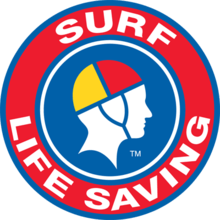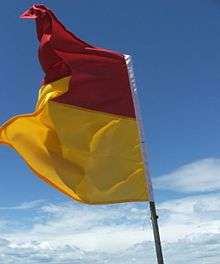Surf Life Saving Australia
 | |
| Abbreviation | SLSA |
|---|---|
| Predecessor | Surf Bathing Association of New South Wales |
| Formation | 18 October 1907 |
| Headquarters | Rosebery, Sydney, NSW |
Region served | Australia |
Membership | 166,923 (2013)[1] |
President | Graham Ford |
Key people | Greg Nance (CEO) |
| Subsidiaries | Westpac Life Saver Rescue Helicopter Service |
| Affiliations | International Life Saving Federation |
Budget | A$19.794 million (2012)[2] |
Staff | 47 (2012)[2] |
| Slogan | Australian for life |
| Website |
sls |
Formerly called | Surf Life Saving Association of Australia |
Surf Life Saving Australia (SLSA) is an Australian not-for-profit community organisation that promotes water safety and provides surf rescue services.
SLSA strives to create a safe environment on Australia's beaches and coastline through patrols, education and training, public safety campaigns and the promotion of health and fitness. As of 30 June 2013 the organisation had 166,923 members with 311 affiliated surf life saving clubs,[1] making it reputably the largest volunteer movement of its kind in Australia. The majority of its services are provided by volunteer lifeguards, called surf lifesavers, that provided 1.4 million hours of service, rescued 11,533 people, and provided 64,645 first aid treatments during 2013.[1] In 1973, the organisation established the Westpac Life Saver Rescue Helicopter Service that, during 2013, delivered 1,300 rescue missions via helicopter.[1]
Surf Life Saving Australia also operates Australia's largest lifeguard service, contracting to local government and other coastal land managers. Additional income is sourced through community donations, fundraising and corporate sponsorship. SLSA is a foundation member of the International Life Saving Federation (ILS) and plays a vital leadership role in developing lifesaving, beach safety and drowning prevention standards around the world. SLSA is an active part of Australian local communities. It is an organisation which prides itself on offering mateship, education, experience and in doing so gives back to the community.
History
In 1902 it was against the law to enter the ocean during daylight hours in Australia .[3] A Sydney newspaper editor William Gocher announced his challenge of this law at Manly Beach.[3][4] Eventually as more people began to challenge the law it was reversed but inexperienced swimmers were having problems with unusual surf conditions such as rip currents and the number of drownings increased.[3] Groups of volunteers began to patrol the beach to assist and in 1906 the Bondi Beach Surf Bathing Association was formed.[3] The Surf Bathing Association of New South Wales was formed on 18 October 1907 when nine voluntary surf life saving clubs and representatives of the Royal Life Saving Society (RLSS) met and affiliated to represent the interests of surf lifesavers.[5] In attendance were:"Royal Life Saving Society, Manly Surf Club (this a different organisation to the Manly Life Saving Club which was formed in 1911[6]), Bondi Surf Bathers' Life Saving Club, Coogee Surf Life Brigade, Bronte Surf Brigade, Bondi Surf and Social Club (North Bondi SLSC), Tamarama Surf Club (only lasted a few weeks/months and then collapsed), Maroubra Surf Club, United Wanderers Surf Club and Woollahra Surf Club."[5] The meeting resolved:
That it is desirable to form an association of surf clubs, to secure improved facilities for surf bathing, and otherwise promote and regulate the sport..." and "That the association be called 'The Surf Bathing Association of N.S.W.'[7]
The name was changed to Surf Life Saving Association of Australia (SLSAA) in 1922;[5] and changed again in 1991 to the current Surf Life Saving Australia.[5]
Women were actively involved in surf-lifesaving for many years, and in 1980 the association rules were changed so that they could become active patrolling members of the SLSA.[8]
Lifesaving
SLSA's mission is to provide a safe beach and aquatic environment throughout Australia, through patrolling beaches, education, coastal risk assessments and training. Since 1907, surf lifesavers have rescued over 615,000 beachgoers. In 2011/12, surf lifesavers and ALS Lifeguards performed 15,428 rescues, 34,978 cases of first aid and over 928,578 preventative actions on Australia's beaches.
Membership
As of 30 June 2012 SLSA had a membership base of 165,820. SLSA also has 63,157 junior members, or Nippers as they are more commonly known. Nippers are aged between 5–13 years and learn beach safety and awareness skills, in a fun and healthy environment.
Training
Surf lifesavers must be competent swimmers and skilled in rescue techniques, resuscitation and first aid. The entry level qualification to be a surf lifesaver is the Bronze Medallion/Certificate II in Public Safety (Aquatic Rescue). Volunteers must be at least 15 years old to undertake this qualification, which involves theory and practical training, and an assessment of patrolling and lifesaving skills.
Upon completion of the Bronze Medallion/Certificate II, surf lifesavers are encouraged to undertake additional training in the areas of Emergency Care, Powercraft, Beach Management, Aquatic Rescue and Training and Assessment. Lifesavers must also participate in an annual skills maintenance session to ensure that they maintain and update their skills.
International Development
Surf Life Saving in Australia has provided and continues to provide support and expertise to many allied lifesaving organisations across the globe. Contributing to the International Life Saving Federation’s global effort to reduce injury and death in, on, or around water, Surf Life Saving exchanges information and best practice and supports the establishment of lifesaving services in areas of the world where they are needed.
Most of Surf Life Saving’s international work is undertaken in the Asia-Pacific region, not only due to geographical location, but also because of the aquatic environments within the region. Also, as the largest developed country within the Asia Pacific region, a great deal of responsibility to support developing countries lies with Australia.
Research
Surf Life Saving Australia is focused on exploring statistical and analytical data to support development of education, technology, communications and operations to reduce coastal drowning deaths in Australia. Although SLSA has been conducting research for many years, 2010 was the birth of a dedicated and thorough research program. The SLSA Research Scheme was introduced to adopt rigour into research project design and provide funding for targeted and priority research projects.
2007 Year of the Surf Lifesaver
In 2004, the Australian Government declared 2007 the Year of the Surf Lifesaver and allocated funding of A$1 million over three years for Surf Life Saving Australia to celebrate its centenary.[9][10]
See also
- Royal Life Saving Society Australia
- 1907 Sydney bathing costume protests
- Australian Water Safety Council
References
- 1 2 3 4 "Snapshot" (PDF). Annual Report. Surf Life Saving Australia. 2013.
- 1 2 "Annual Report" (PDF). Surf Life Saving Australia. 2012. Retrieved 30 December 2013.
- 1 2 3 4 Fenner, Peter J (2005). "Surf Life Saving Australia". South Pacific Underwater Medicine Society Journal. 35: 33–43. Retrieved 2012-01-19.
- ↑ Mitchell, Bruce (1983). "Gocher, William Henry (1856-1921)". Australian Dictionary of Biography. National Centre of Biography, Australian National University. Retrieved 30 December 2013.
- 1 2 3 4 O'Byrne, Garry Browne (Nov–Dec 2006). "Making the Legend Coogee Surf Life Saving Club in the 1950s". AQ: Australian Quarterly. Australian one d. 78 (6): 13–21.
- ↑ Coulter, Stephen (26 July 2010). "Manly Life Saving Club is Australia and the World's First Surf LifeSaving Club". The Manly Daily. Archived from the original on 24 August 2010. Retrieved 17 August 2011. and "History". Manly Lifesaving Club. Retrieved 17 August 2011.
- ↑ http://surflifesavingsydney.com.au/about-us/history/
- ↑ Henningham, Nikki (16 May 2007). "Surf Lifesaving Australia (1907 - )". Australian Women's Archives Project. The Australian Women’s Register. Retrieved 17 August 2011.
- ↑ Dawson, Andrew (12 May 2004). "Government kicks in $273m for Commonwealth Games". The Canberra Times. via factiva.com. p. 18.
- ↑ Farrelly, Kate (10 July 2004). "A whole lot more out of life". The Sydney Morning Herald. My Career (liftout). via factiva.com. p. 1.
